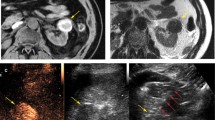Abstract
Objective
To retrospectively assess the safety and oncological efficacy of percutaneous image-guided cryoablation (CA) of T1b (> 4 cm/< 7 cm) renal tumors.
Materials and Methods
Institutional electronic records were retrospectively reviewed to identify the patients who had undergone percutaneous CA of T1b renal tumors between 2008 and 2016. CA was proposed by a multidisciplinary tumor board for cases with poor renal function or a single kidney; unsuitable for surgical resection; or genetic syndromes predisposing to multiple hereditary renal tumors.
Patients’ demographics, procedural and follow-up data were accurately collected and analyzed.
Results
Twenty-seven consecutive patients (12 females, 15 males; mean age 72.3 ± 14.3 years) were included. Mean tumor diameter was 47.9 ± 6.3 mm. MRI guidance was used in 6/27 cases (22.2%) and CT guidance in the remaining 21/27 (77.8%) cases. Hydro- and/or carbo-dissections were necessary in 21/27 cases (77.8%). Complications graded ≥ II were reported in three (11.1%) patients. Technical success and technical efficacy were 100 and 87.5%, respectively. Local tumor control (LTC) evaluated at imaging follow-up ≥ 6 months was 82.6, 72.3 and 60.3% at 12-, 24- and 36-month follow-up, respectively. One patient passed away 3 months after CA due to the metastatic evolution of the primary kidney cancer.
Conclusion
Percutaneous CA of T1b renal tumors is safe and satisfactory rates of LTC are expected at the early follow-ups. Further studies are needed to confirm the long-term efficacy of this procedure.




Similar content being viewed by others
References
Howlader N, Noone AM, Krapcho M, Miller D, Bishop K, Altekruse SF, et al. SEER cancer statistics review, 1975–2013. Bethesda. National Cancer Institute. http://seer.cancer.gov/csr/1975_2013/.
Smith SJ, Bosniak MA, Megibow AJ, Hulnick DH, Horii SC, Raghavendra BN. Renal cell carcinoma: earlier discovery and increased detection. Radiology. 1989;170(3 Pt 1):699–703.
Huang WC, Elkin EB, Levey AS, Jang TL, Russo P. Partial nephrectomy versus radical nephrectomy in patients with small renal tumors—is there a difference in mortality and cardiovascular outcomes? J Urol. 2009;181(1):55–62.
Miller DC, Schonlau M, Litwin MS, Lai J, Saigal CS. Renal and cardiovascular morbidity after partial or radical nephrectomy. Cancer. 2008;112(3):511–20.
Campbell S, Uzzo RG, Allaf ME, Bass EB, Cadeddu JA, Chang A, et al. Renal mass and localized renal cancer: AUA guideline. J Urol. 2017;. doi:10.1016/j.juro.2017.04.100.
Atwell TD, Schmit GD, Boorjian SA, Mandrekar J, Kurup AN, Weisbrod AJ, et al. Percutaneous ablation of renal masses measuring 3.0 cm and smaller: comparative local control and complications after radiofrequency ablation and cryoablation. Am J Roentgenol. 2013;200(2):461–6.
Jasinski M, Siekiera J, Chlosta P, Mikolajczak W, Drewa T. Radiofrequency ablation of small renal masses as an alternative to nephron-sparing surgery: preliminary results. Wideochir Inne Tech Maloinwazyjne. 2011;6(4):242–5.
Thompson RH, Atwell T, Schmit G, Lohse CM, Kurup AN, Weisbrod A, et al. Platinum priority—kidney cancer comparison of partial nephrectomy and percutaneous ablation for cT1 renal masses. Eur Urol. 2015;67(2):252–9.
Atwell TD, Vlaminck JJ, Boorjian SA, Kurup AN, Callstrom MR, Weisbrod AJ, et al. percutaneous cryoablation of stage t1b renal cell carcinoma: technique considerations, safety, and local tumor control. JVIR. 2015;26(6):792–9.
Parsons RB, Canter D, Kutikov A, Uzzo RG. RENAL nephrometry scoring system: the radiologist’s perspective. AJR Am J Roentgenol. 2012;199(3):W355–9.
Clavien PA, Barkun J, de Oliveira ML, Vauthey JN, Dindo D, Schulick RD, et al. The Clavien-Dindo classification of surgical complications: five-year experience. Ann Surg. 2009;250:187–96.
Ljungberg B, Bensalah K, Canfield S, Dabestani S, Hofmann F, Hora M, et al. EAU guidelines on renal cell carcinoma: 2014 update. Eur Urol. 2015;67(5):913–24.
Maxwell AWP, Baird GL, Iannuccilli JD, Mayo-smith WW, Dupuy DE. Renal cell carcinoma: comparison of RENAL nephrometry and PADUA scores with maximum tumor diameter for prediction of local recurrence after thermal ablation. Radiology. 2017;283(2):590–7.
Caputo PA, Zargar H, Ramirez D, Andrade HS, Akca O, Gao T, et al. Cryoablation versus partial nephrectomy for clinical T1b renal tumors: a matched group comparative analysis. Eur Urol. 2016;71(1):2–8.
Volpe A, Amparore D, Mottrie A. Treatment outcomes of partial nephrectomy for T1b tumours. Curr Opin Urol. 2013;23(5):403–10.
Patard JJ, Pantuck AJ, Crepel M, Lam JS, Bellec L, Albouy B, et al. Morbidity and clinical outcome of nephron-sparing surgery in relation to tumour size and indication. Eur Urol. 2007;52(1):148–54.
Okhunov Z, Moreira DM, Del Junco M, Abedi G, Lobko II, Kaler KS, et al. Predictors of complications after percutaneous image-guided renal cryoablation for T1a renal cortical neoplasms. J Endourol. 2017;31(1):7–13.
Kurup ANAN. Percutaneous ablation for small renal masses-complications. Semin Interv Radiol. 2014;31(1):42–9.
Kakarala B, Frangakis CE, Rodriguez R, Georgiades CS. Hemorrhagic complications of percutaneous cryoablation for renal tumors: results from a 7-year prospective study. Cardiovasc Interv Radiol. 2016;39(11):1604–10.
Atwell TD, Farrell MA, Leibovich BC, Callstrom MR, Chow GK, Blute ML, et al. Percutaneous renal cryoablation: experience treating 115 tumors. J Urol. 2008;179(6):2136–41.
Woodrum DA, Atwell TD, Farrell MA, Andrews JC, Charboneau JW, Callstrom MR. Role of intraarterial embolization before cryoablation of large renal tumors: a pilot study. J Vasc Interv Radiol. 2010;21(6):930–6.
Author information
Authors and Affiliations
Corresponding author
Ethics declarations
Conflict of interest
All authors have no conflicts of interest to disclose.
Ethical Approval
All procedures performed in studies involving human participants were in accordance with the ethical standards of the institutional and/or national research committee and with the 1964 Helsinki declaration and its later amendments or comparable ethical standards.
Rights and permissions
About this article
Cite this article
Hebbadj, S., Cazzato, R.L., Garnon, J. et al. Safety Considerations and Local Tumor Control Following Percutaneous Image-Guided Cryoablation of T1b Renal Tumors. Cardiovasc Intervent Radiol 41, 449–458 (2018). https://doi.org/10.1007/s00270-017-1820-0
Received:
Accepted:
Published:
Issue Date:
DOI: https://doi.org/10.1007/s00270-017-1820-0




